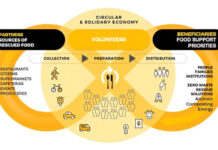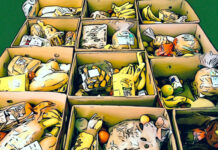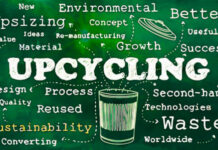The report ‘From Field to Bin: The Environmental Impacts of US Food Waste Pathways’, published in October 2023 by the EPA (Environmental Protection Agency), offers a valuable analysis of the impacts of ‘Food Loss and Waste’ (FLW) on the environment. (1)
1) Food Loss and Waste (FLW), the EPA report
‘EPA estimates that the United States wastes between 73 and 152 million tons/year of food, equal to 223 to 468 kg (492 to 1.032 lb) of food per person per year, equal to approximately 35% of the US food supply ( U.S. EPA 2021c)‘. Food is the most commonly wasted material in the United States, accounting for 24% and 22% of municipal solid waste (MSW) disposed of in landfills and burned, respectively.
Food Loss and Waste (FLW) – that is, food losses in the production and logistics phases and food waste in distribution, sale and consumption (2) – involve a wide range of stakeholders, from farms to food businesses, families and managers some waste. In addition to the public administration, which in 2015 made a commitment to halve FLW by 2030, in line with Sustainable Development Target 12.3 in the UN Agenda 2030. (3)
2) Analysis methods
The EPA report have used Life Cycle Assessment (LCA) e Circularity Assessment to evaluate the environmental impacts and contribution towards the circular economy of eleven strategies for the prevention of FLW and the management of ‘sidestream materials’, from food donations and upcycling (4) to recycling, energy valorisation and finally disposal.
A revision of approximately 250 product life cycle analyzes made it possible to determine the environmental impacts, as well as perform a qualitative assessment of the contribution of each path to a circular economy. To do this, EPA researchers used the following tools and data:
– Landfill Gas Emissions Model (LandGEM). A model for estimating gas emission rates (methane, carbon dioxide, non-methane organic compounds and individual air pollutants, total gases) produced by municipal solid waste landfills;
– Waste Reduction Model (WARM) provides estimates of total greenhouse gas emissions over the life cycle of products, linked to various waste management practices, including landfill disposal;
– Inventory of U.S. Greenhouse Gas (GHG) records the emissions and removals of greenhouse gases attributed each year to each source and economic sector, from 1990 to the present;
– Landfill and Landfill Gas Energy Database (LMOP Database) collects key data for municipal solid waste landfills in the United States, including information on landfill gas energy projects.
3) Wasted Food Scale
Wasted Food Scale (on the cover) is the new hierarchy of the eleven possible paths (or destinies) of FLW – from the most virtuous to the least advantageous from an environmental point of view – developed by EPA to replace the previous Food Recovery Hierarchy, which the agency had developed in the 90s of the last century. The new hierarchy reflects the ‘best practices’ as well as the scientific and technological advances developed in recent decades to reduce ‘food loss’, ‘food waste’ and their negative impacts on the environment.
Some routes (i.e. donate, upcycle) are placed on the same level, as EPA considers the equivalence of their environmental performance. The updated hierarchy highlights the value of prevention and the need to remove food waste from landfill disposal routes. The report ‘Quantifying Methane Emissions from Landfilled Food Waste‘ in turn shows the CH4 emissions produced by decomposing food waste in municipal solid waste landfills, in the USA, from 1990 to 2020 (5,6).
4) ‘From Field to Bin’, conclusions
The conclusions of the EPA report – in line with the scientific literature and the data collected so far in the Wasteless research project, in Horizon Europe, in which our Wiise team participates (2,7) – reveal the following:
– food overproduction is the first and most serious problem to face. (8) Even with specific regulatory and/or fiscal measures, adds the writer, or through the imposition of specific reporting in the ESG (Environmental, Social, Governance) field;
– food donations and upcycling, following, are the most virtuous paths (4,9,10). Although their benefits are not comparable with respect to the environmental impacts of production;
– the recycling of FLW in soil amendments offers the opportunity to improve the health of soils in the long term and to contribute to the renewal of ecosystems, thanks to the recovery and return of nitrogen and carbon to the soil;
– disposal of FLW in landfills and wastewater treatment plants has a significant impact on methane emissions.
Dario Dongo and Gabriele Sapienza
Footnotes
(1) Part 2 – From Field to Bin: The Environmental Impacts of US Food Waste Pathways. EPA (Environmental Protection Agency, USA), Office of Research and Development. EPA/600/R-23/065 http://tinyurl.com/yeyk2e8v
(2) Dario Dongo, Andrea Adelmo della Penna. Food loss and waste measurement systems, FLW. Survey and network. GIFT (Great Italian Food Trade). 10.11.23
(3) Alessandra Mei. Food loss and waste, the US action plan to reduce food waste. GIFT (Great Italian Food Trade). 26.3.23
(4) Dario Dongo. Upcycling, the main road to research and innovation. GIFT (Great Italian Food Trade). 1.1.23
(5) Quantifying Methane Emissions from Landfilled Food Waste http://tinyurl.com/mshx6n3b
(6) The analysis performed in the report referred to in note 5 shows the growing trend in methane emissions coming from food waste disposed of in landfills, in contrast to the total CH4 emissions from municipal solid waste landfills. Confirming the enormous impact food waste sent to landfill has on methane emissions
(7) Dario Dongo, Andrea Adelmo della Penna. Wasteless, EU research project on circular economy and blockchain. GIFT (Great Italian Food Trade). 5.9.22
(8) Giuliano Vulcano, Dario Dongo. Food waste, a systemic approach to tackle the ecological and social crisis. GIFT (Great Italian Food Trade). 13.9.19
(9) Dario Dongo, Giulia Pietrollini. Food waste, a systemic approach to tackle the ecological and social crisis. GIFT (Great Italian Food Trade). 31.1.23
(10) Dario Dongo, Giulia Pietrollini. Upcycling of agro-industrial waste into prebiotics and functional ingredients. GIFT (Great Italian Food Trade). 7.4.23









